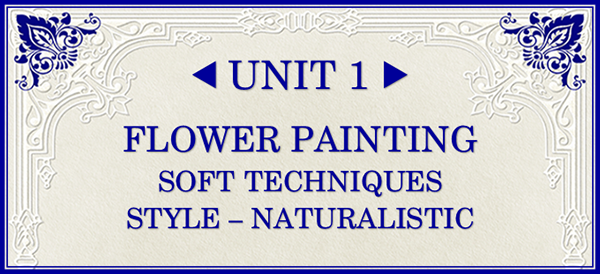
Click HERE to return to the Unit Judging Guidelines page for more details on each unit
or click the quick link button below to go the Unit

✽ UNIT 1 ✽
This Unit must be painted on a glazed porcelain plate, tile or other suitable porcelain shape at least 8inches or 20cm.
AT LEAST TWO different flower varieties, with appropriate foliage, must be represented and clearly recognisable, i.e. Rose and Pansy, Delphinium and Iris, etc. The judges can then be convinced of your ability to paint those two flower varieties. Other varieties may be painted (any number, in fact) but remember TWO must be clearly recognisable.
NO embellishments are acceptable other than optional Gold/Platinum trim and this of course will be judged also, if applied.
Tiles must be suitably framed, but must NOT be under glass.
● NO Bone China
● NO Porcelain Bisque
● NO Porcelain Canvas
● NO Ceramics
● NO Monochrome
● NO Dusting
● NO Metallics
● NO Penwork
● NO Pre-Ground Pieces
● NO Lustre
JUDGING: Read General Judging Guidelines and Judging Guidelines, etc. on Pages 2 - 6 of the "Porcelain Art Teachers New Zealand Judging Guidelines" booklet or here on our site.
FIRING: Look for well matured colours and even glaze.
COLOUR/VALUE:
Tonal Value is one of the most important features in any realistic naturalistic painting. Hard and fast rules about colour are difficult. If the artist has put together colours which look good and give the piece appeal, then it is a success no matter how improbable. Whether the piece is a Major Key (strong contrast) or Minor Key (subdued), the value is most important. Without value there is no way to achieve that rhythmical flow or to stress the order of importance of the various flowers. Look for some colour harmony and some contrast - maybe a suggestion of a complementary colour wafted into the background.
DESIGN/SUITABILITY:
❖ Look for perspective - a recognisable order of importance of the flowers. Flowers, leaves etc. will be placed in such a manner as to lead the viewer around the piece.
❖ Look for good size and shape relationships between the flowers.
❖ Does the design have rhythm?
❖ Does each piece of the design relate to the whole piece or just look tacked on?
TECHNIQUE/APPLICATION:
Paint should be evenly applied, NO chipping or peeling paint. NO build up around wipe out areas.
Don't confuse patchy paint with filter strokes. These give a desirable textured impression and almost allow one to imagine dappled sunlight filtering through the trees onto the flowers.
